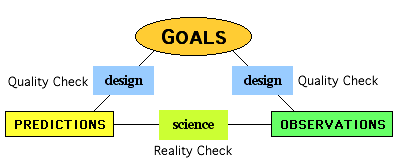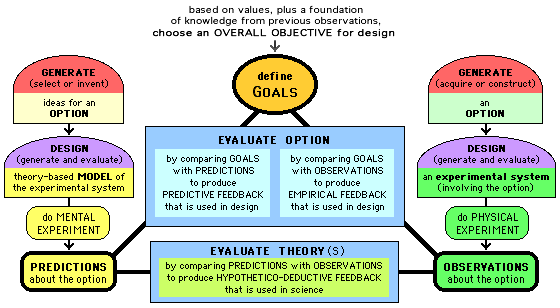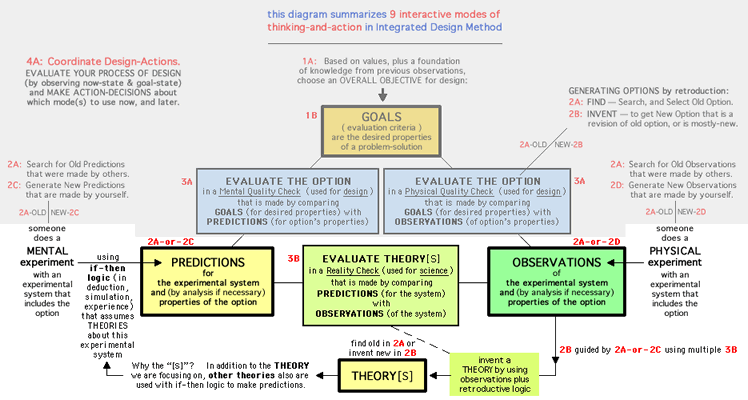Introduction to Scientific Method:
using logical reality checks in science and other areas of lifeThis page is a beginning. It will help you understand the simplicity of scientific method in the simple "reality check" that is the main focus of scientific logic. But along the way you'll see other aspects of scientific thinking skills, and at the end you'll be invited to continue your exploration of “how it all fits together in a big picture” so you can understand the complexity of scientific methods and their potential applications in science education.
|
|
|
| Part 1: The Foundation of Scientific Method — Logical Reality Checks Situations allow Observations and Theories allow Predictions Theory Evaluation (by comparing Observations & Predictions) Theory Generation (by an imaginative use of Reality Checks) Designing Observation-Situations — Generation & Evaluation |
Part 2: |
The Foundation of Scientific Method — logical Reality Checks
You can understand and enjoy the adventure of science, because the thinking used in science is not strange and mysterious, it's the same thinking you use in daily life. In scientific logic, as in daily life, you use reality checks to decide whether "the way you think the world is" matches "the way the world really is." We'll begin by looking at the central activity of modern scientific method, when OBSERVATIONS (from an Experiment) and PREDICTIONS (based on a Theory) are compared in a REALITY CHECK that is a test of quality for a Theory:MAKING OBSERVATIONS
In science, information about nature comes from our observations. Consider two types of observation-situations:a) For several months you make observations about the moon's appearance, and the times and locations of its rising and setting.
b) You observe the growth of young plants in many contexts, by varying many factors: light, temperature, type of seed (lima bean,...), type of soil, amount and frequency of watering, amount and type of fertilizer, treatment of seed (by soaking, cooking,...) before planting, and more. You try different combinations of factors, and for each experiment you make observations both above and below the soil surface, before and after the plant grows through the surface.
A) In an uncontrolled observation-situation (like observing the moon) the situation is set up by nature. B) In a controlled observation-situation (in the designed experiments with seeds) humans set up the situation, but "what happens" depends on nature. The degree of human control, in setting up an observation-situation can range from no control through partial control to total control. Observations throughout the range-of-control can be logically compared with predictions to allow reality checks. Therefore, in this page all observation-situations will be called experiments, even though in general the term "experiment" is reserved for situations that are at least partially controlled.
We observe using human senses (to see, hear, touch, taste, or smell) plus instruments (watch, ruler, scale, pipet, compass, thermometer, microscope, telescope, spectrometer, chromatograph,...) that help us measure more precisely and observe more widely.
We translate raw data (from senses or instruments) into "observations" that we record using symbolic representations that are verbal (words,...), visual (pictures,...), and mathematical (numbers,...).
I.O.U. — Later, this section will include more ideas about the creative generation and critical evaluation of "opportunities for observation" during the process of experimental design.
THEORIES allow PREDICTIONS
A theory is a human attempt to describe and/or explain our observations of what happens, or (in historical science) what has happened. A descriptive theory claims only to describe what happens. An explanatory theory claims to describe what happens and also why it happens.With a descriptive theory, predictions are made by generalizing, in an extrapolation that assumes "what happened before – in situations that are similar (but usually not identical) – will happen again." Or, you could view this prediction as a use of if-then deductive logic: "If this situation is similar to previous situations (as claimed by the theory), then we should expect a result that is similar." For example, you could predict the time and location of the moonrise on Wednesday, by extrapolating based on patterns you recognized while thinking about observations from Sunday, Monday, and Tuesday.
An explanatory theory claims to explain "how and why things are happening" in an experimental system by describing — verbally, visually, and/or mathematically — the system's composition (what it is) and operation (what it does). You can use this model to make predictions by answering the question, "In this situation, if the composition-and-operation model is true (as claimed by the theory), then what will happen and what will we observe?"
With either type of theory, the if-then inference is similar. You run a mental experiment by thinking, "In this situation, IF the system behaves as expected (according to the theory), THEN we will observe ___" and what you put in the blank is your theory-based prediction.
When scientists make an if-then inference, they can move from IF to THEN in a variety of ways. They might remember what has happened before, and extrapolate from this past into the future by estimating how similarities and differences in situations (when comparing previous situations with the current situation) will translate into similarities and differences in observations. Or, if a theory includes an equation or a model, they could substitute numbers into the equation and calculate, or "run the model" in their minds or in a physical simulation or computer simulation. If predictions can be made using several methods, this will serve as a check on the predicting methods and a cross-check on the predictions.
A theory-based inference about "what will happen and what will be observed" can be made either before or after observations are known. When an inference is made after observations are known, there is more concern about unconscious bias or conscious cheating, since non-valid logic could be used in an attempt to achieve a match between the inference and the known observations. But inferences with either timing are logically equivalent if each is obtained using valid logic, and in science both are called "predictions".
•
THEORY Evaluation (leading to Theory Status)
The logical foundation
of scientific method is the reality check. By
observing reality and using logic, scientists can decide whether
a theory about "the way it is" corresponds with "the way it really
is."
A physical experiment allows observations of what
nature actually does, and a mental experiment lets
us make predictions about what nature will
do. In a reality check, scientists
compare OBSERVATIONS with THEORY-based PREDICTIONS. If a theory
fails in reality checks because its predictions do not match observations,
scientists can reject the theory.* By
contrast, a correct prediction does not prove a theory is true, because
other theories (current or future) might make the same correct prediction. To
distinguish between two theories, we need to observe what happens in a
crucial experiment that provides a situation where the two theories make different predictions. {* But
a decision to reject a theory is a judgment call, and scientists may be
cautious about immediately claiming "falsification" after a failed reality
check, due to the possibility that their knowledge (of the situation, observations,
or predictions) is inaccurate. }
Multiple
Independent Confirmations: When a theory makes correct predictions
in a wide variety of independent areas, and alternative theories make incorrect
predictions, this provides strong evidence that the repeatedly confirmed
theory is true.
Usually, empirical
factors (based on reality checks) are the main factors in
theory evaluation. But scientists also consider conceptual
factors such as a theory's logical characteristics (like internal
consistency and structural simplicity) and its relationships with
other currently accepted theories. Scientists are also influenced
by cultural-personal factors (such as
personal desires, group pressures, practical considerations, philosophical & religious views, metaphysical perspectives,
personal thinking habits, cultural thought styles) but most scientists think the quality
of science decreases when these factors affect the results of theory
evaluation.
The overall result of theory
evaluation is an estimate of theory status. This
status, which can range from very low to very high, indicates the scientists'
confidence in a theory. Most scholars who study science think we
cannot logically prove a
theory is either true or false, but we can develop a rationally
justified confidence in our conclusions.
A VISUAL SUMMARY
The
diagram below, which shows the essence of scientific
method, has three main elements: OBSERVATIONS & PREDICTIONS (these
two are compared in a REALITY CHECK) and THEORY. If
you study the diagram and think about what you've been reading, it
should
make
sense. Notice
the arrows pointing away from THEORY (because a theory is used
for making
the predictions used to evaluate a theory, as explained
above) and toward THEORY (because observations are used to generate
a theory, as explained below).

• THEORY Generation
The focus now shifts
from theory evaluation to theory generation,
with thinking that is both creative and critical, when we
ask "Where
do scientific theories come from?"
Usually, scientists work with
theories that already exist. But earlier in the history of science
these theories had to be generated. And sometimes current scientists
invent their own new theories, usually by revising old theories. Typically,
the process of generation is different for a descriptive theory and explanatory
theory.
A descriptive
theory is generated when scientists recognize a pattern, when they
notice that in a certain type of situation a particular result happens. They
describe the observed regularity by claiming that "In this situation (when
___ ), ___ will happen." For example, we can say that "When an object
is released, it will fall toward the ground." But is this theory
always correct? How do we react, thinking as scientists, when we
see that some objects — such as a helium balloon, bottle rocket,
or bird — do not fall? We revise our general theory, limiting
its claims by saying that "In most situations, a released object will fall
downward." And we try to find theories that explain why the regularity
occurs, and why the exceptions occur. For example, we can explain
the rising of a helium balloon by proposing the existence of an upward
buoyant force that causes lighter-than-air objects to rise in air. And
we can generalize this force to other objects and fluids, to also explain
why a cork floats on water.
An explanatory
theory is usually generated by a process of creative
thinking in which imagination is guided by the logic of reality
checks, with creativity being stimulated by observations and guided
by critical thinking. In prediction we
ask a cause-to-effect question: "In
this situation, if these causes are operating, what will be the observed
effects?" The if-then reasoning is reversed in retroduction (using retroductive logic) when
we ask an effect-to-cause question: "In
this situation, if these effects were observed, what causes could
have been operating?" This reversed question inspires a search
in which we do mental experiments over and over, each time "trying
out" a different theory in an attempt to produce predictions that
match the known observations. The goal is to find a theory
that will pass the reality check, to find a theory that, if true,
would explain what has been observed. { In the diagram
above, you can imagine a "feedback cycle" for the three
main elements,
with each reality-check providing feedback that helps you use OBSERVATIONS
to
retroductively
generate
a new THEORY
whose new PREDICTIONS will more closely match the old OBSERVATIONS
in the next reality-check. In this way there is an intimate
blending of creative generation with critical
evaluation. }
Sometimes the distinction between description and explanation isn't
clear, so we also have semi-explanatory theories.
But do scientists typically design theories? In their daily work, scientists
rarely design large-scale generalized mega-theories,
such as the theories of gravity, invariance, or evolution developed by Newton,
Einstein, or Darwin. Instead, usually they are applying generalized
theories that already are accepted, in their study of particular experimental
situations for which they are designing small-scale specialized sub-theories. For
example, a group of chemists might apply generalized theories (atomic theory,
quantum mechanics, kinetics, thermodynamics,...) to a particular experimental
system, or a collection of systems,
in an effort to design a sub-theory that seems
to
be
true (and/or
useful) for these systems.
Or, more commonly, scientists simply
accept the mega-theories & sub-theories developed by others, so they can
make observations and learn
more about nature in the experiments (controlled or uncontrolled) they
are designing and running.
You can be a scientist, generating your own theory to explain moon phases, by "running a model" for the sun-earth-moon system.* Darken a room, turn on a lamp to be the sun, use one ball for the earth — with a marker (a sticker, a pin,...) to show your location on earth, so you can imagine "what you will see" from that location — and another ball for the moon. By looking at the effects of earth's rotation around its axis, and the moon's orbit around earth, you should also be able to explain why the sun sets in the west, and why there is a pattern for moon phases and the associated times of moonrises and moonsets.
• EXPERIMENTAL Design — Creative Generation and Critical Evaluation
By defining the term broadly, experiments can include all observation-situations, both controlled
experimental situations and uncontrolled field situations that can be called field experiments or natural experiments.
When scientists
design an experiment (or set of experiments) their general goal is to fill gaps in current knowledge by gathering information about experimental
systems or techniques. More specifically, an
experiment can be done to "see what will happen" in a new situation or to test the reproducability of observations from previous experiments, to resolve an anomaly, impress a funding
agency, or provide support for an argument, as in a crucial
experiment that can distinguish between competing theories.
Scientists often
run thought experiments — usually so they can be more efficient (to waste less
of their valuable time and resources), but also occasionally for systems that cannot be physically observed — by asking "if we do
this,
what might happen and what would we learn?" * The previous section ended with one type of thought experiment, "running a model" and using physical objects to make your visual thinking more easy and effective. Another type of thought experiment, becoming much more common during the past few decades, are the computer simulations that help scientists do mathematical thinking more easily and effectively. / Another type of thought experiment is to imagine
the
questions
that
will
be
asked, by yourself and others,
during evaluation — "is the sample large enough and does it accurately
represent the whole population?" or "what are the effects of systematic
errors and random errors?" or... — and then design experiments to answer
these questions.
New opportunities
for experimenting can arise from new events (like an ozone hole)
or new discoveries (of old dinosaur bones,...). Scientists
may want to test a new sub-theory or explore its application for
a variety of systems. A new observation technology may allow
new experimental systems. Scientists who are aware and creative,
thinking with open-minded imagination,
can take advantage of opportunities.
Part 2
Does a scientific method exist?
Is there a scientific method? If "method" means "a
single method, used in the same way by all scientists at all times," the answer
is NO. Some details of methods change with time and culture, and vary from
one
area
of science to another, so there is nothing that could be called The
Scientific Method. But some scientific methods are
commonly used by scientists.
The methods of scientists are
designed to be functional, to achieve goals. For most scientists, the
main goal is to find truth. They want to construct theories that are
true, that correspond with reality by correctly describing what really happens
in nature. In a search for true theories, the main thinking tools — the
generation and evaluation of theories, using observation, imagination, and
logic — are described above.
But scientists do more
than just generate and evaluate theories. They also design and
do experiments, plan big research projects and small daily activities,
describe (by writing and talking) their own research, learn (by reading
and listening) about the research of others, discuss ideas with other
scientists, and more. Basically, scientists do — mentally
and physically — whatever they think will help them achieve their
goals.
The methods of science
are flexible, not rigid. Consider two types of ice skaters. The
sequential actions of a figure skater are precisely planned and, if
there are no mistakes, predictable. By contrast, even though
hockey skaters have a strategic plan, the plan is intentionally flexible,
with each skater improvising in response to what happens during a game. The
methods used in science are analogous to the flexible "structured improvisation" of
a hockey skater, not the rigid choreography of a figure skater.
These ideas are examined in more
detail in a page asking "Is there a scientific
method?"
In Part 1 you saw a logical-structural analysis of science & design, focusing on logic. But in science, decisions are made by people. This adds another layer of complexity; in real life, scientists are motivated and guided by a wide variety of factors that extend beyond logic to include cultural-personal factors, as described below in Controversy and Complexity.
Controversy and Complexity
Scholars, including scientists and those (in philosophy,
history, sociology, psychology, and education) who study science, have vigorous
discussions about the methods used in science. Some of the most hotly debated
questions are about cultural-personal influences in the process of science, especially
in evaluations of scientific theories: Are cultural-personal effects significant,
and are they desirable? Most scientists think these effects should be minimized,
but some scholars (especially nonscientists who have adopted a postmodern perspective)
think cultural-personal factors should be a part of scientific theory evaluation.
I claim that empirical factors
are usually (but not always) the main factors (but not the only factors)
during theory evaluation, that conceptual factors are usually (but not
always) scientifically useful, and that cultural-personal factors should
be recognized (they do occur) and minimized (because they usually are
not scientifically useful). In what ways, and to what extent, are
the process and results of evaluation influenced by conceptual factors
and
cultural-personal factors? The influence varies, because it depends
on the scientists (and their culture) and the theory. And it depends
on who is answering the question, since this is a topic for hot debate
among scientists and (especially) the scholars who study science.
Most of
this page has emphasized the importance of empirical "reality
checks" and the simplicity of science. But I
also recognize the effects of non-empirical factors
and the complexity of science, as explained below.
I've developed a "model for the methods of science" that describes nine aspects of what scientists do:
| 1. Hypothetico-Deductive Logic, and Empirical Factors in Theory Evaluation 2. Conceptual Factors in Theory Evaluation 3. Cultural-Personal Factors in Theory Evaluation 4. Theory Evaluation (using critical thinking) 5. Theory Generation (using creative thinking) 6. Experimental Design (Generation-and-Evaluation) 7. Problem-Solving Projects 8. Thought Styles (cultural and personal) 9. Mental Operations (creative-and-critical thinking) |
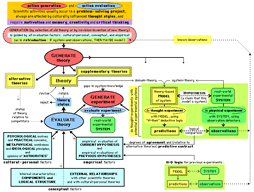 |
The diagram to the right, which is similar to the one above but with less detail, shows 9 aspects of Scientific Method: 3 of them [123] for evaluation factors (empirical, conceptual, cultural-personal), another 3 [456] for the designing (generation & evaluation) of theories and experiments, 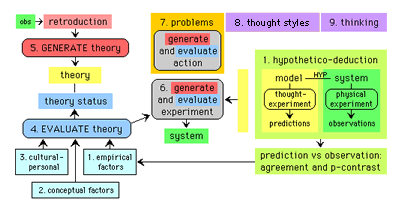 and 3 [789] for the process of science (problem-solving projects, thought styles, productive thinking).
and 3 [789] for the process of science (problem-solving projects, thought styles, productive thinking).
Because my model shows the functional relationships between these 9 aspects of science by integrating their relationships
into a coherent framework, I call it Integrated Scientific
Method. This model of scientific thinking, for the exploratory process of inquiry used by scientists when they ask questions and try to find answers, is a unifying synthesis of ideas (mainly from scientists and philosophers, but also from sociologists, psychologists, historians, and myself) that can be useful for understanding the methods of problem solving used in science, and for helping students improve their skills with these methods of thinking.
My model of scientific methods is not THE Scientific Method, and its 9 parts are aspects of science rather than steps in a sequence. This model is outlined, verbally and visually, in A
Basic Overview of Scientific Method and is examined with more depth in A
Detailed Overview of Scientific Method which is a condensation of the first
half of my PhD dissertation; the second half was the application of this model for the integrative analysis of a science-inquiry classroom.
.
In the page you're now reading, you already have seen some of the nine perspectives on scientific thinking-and-action. In this page the main focus has been "reality checks" using hypothetico-deductive logic (1), but you've also seen the process of theory generation (5) and theory evaluation (4) and how a theory is designed using "quality checks" with the criteria for quality based on a combination of empirical factors (1) and conceptual factors (2) and cultural-personal factors (3), and everything is infused with the productive mental operations (9) of creative idea-generation and critical idea-evaluation.
| A Model for Design Process This page includes a brief outline [which needs revising - iou] of Science as Design. You can learn more about design strategies — which are used for almost everything you do in life — in An Introduction to Design which gives real-world examples of problem solving and the process of design, plus outlines of design-and-science relationships (which are explored more deeply in Design & Science) and educational applications of Design Process & Scientific Method; and An Overview of Design Process offers a "modes of thinking-and-action" perspective that complements An Introduction to Design. |
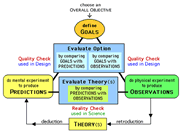 |
Continued Explorations of Science, and Applications for Education
Learning a basic model of scientific method, as in
this page, is a good way to begin. But usually it isn't a good place
to end. If you want to understand science more completely, and appreciate
it more fully, I encourage you to continue your journey of exploration beginning with the Basic
Overview of Integrated Scientific Method (link is above) which will help
you learn more about the fascinating complexity of science. You can also
study the hot debates about science: Should
scientific method be eks-rated?
And in an occasionally controversial
area, educators (plus parents, school boards,...) think about the goals
and methods of general education and science education. In all types
of schools — public, private, and home, from K-12 through college — teachers
are wondering how the logical
thinking skills of science can be taught more effectively in the classroom. They want to offer
a quality education that includes scientific concepts plus thinking skills,
so students will be motivated to learn, and will learn how to think more often
and more effectively, with enthusiasm and skill. A wide variety of questions — about
creative-and-critical thinking, curriculum design, teaching strategies,... — are explored in the
areas for thinking skills & teaching methods. [update: In early 2012, I began making a "condensed website" for these ideas, Using Design Process in Problem Solving and Education, which I recommend; the next three links are for the older web-pages that I'm condensing.] A good starting place is the conclusion of An Introduction to Design which leads to Problem Solving & Metacognition in Education. Also check An Overview of Design Process.
And for continued exploration, you can see what's available in an overview-sitemap
for Design Process & Scientific Method
in Education — Developing a Curriculum for Thinking Skills and Problem Solving where you'll see links to pages asking "How can we use Aesop's Activities for goal-directed education?" and more.
APPENDIX
Semi-Explanatory Theories
Philosophers of science
ask, "What is required for an adequate explanation?", and
they don't offer easy answers. They say that even though distinguishing
between description and explanation can be useful, usually it isn't
entirely accurate because most modern theories claim to explain some
things but not everything.
Consider, for example, Newton's
theory of gravity. It describes what happens: two objects attract
each other with a force of GMm/R2 where G is a constant of
nature, M and m are the objects' masses, and R is the distance between
their centers. It also provides some explanation: gravitational
force is caused by interaction between the masses of any two objects,
anywhere in the universe. But the explanation is not satisfactory
at deeper levels, when we ask additional questions about how and why: How
is gravitational force produced? Is it associated with an elementary
particle, a graviton? Is it related to strong, weak, and electromagnetic
forces? How is it transmitted through almost-empty space between
the earth and moon? Why does gravity exist? For these questions,
scientists still don't have satisfactory answers.
And other semi-explanatory
theories — which can claim "some explanation but not
a full explanation" — occur in other areas of science.
Visual Representations of Thinking in Science Mode and Design Mode:
Below, the third diagram combines ideas from the top two diagrams
|
This section has a dark-gray background and small font-size because it's not worth reading. Later, I'll either revise it or will remove it. Until then, you should just ignore it. Science as Design — Science Process in the context of Design Process Combining two thinking strategies in
Scientific Method: The basic process of design, shown in the diagram below, begins when you choose an Overall Objective that is the thing (the product, strategy, or theory) you want to design. Imagine that you want to design a product. After you define Goals (for the properties you want the product to have), you generate options (by searching for old products, or inventing new products) and for each option you evaluate its quality (as defined by your goals) in a Quality Check, either by comparing goals (for the desired properties of a product) with predictions (about the actual properties of this product-option) or by comparing goals (for desired properties) with observations (of the actual properties for this product-option). You continue this process of generating options and evaluating them (by using one or both types of Quality Checks) until you decide that one of the options is satisfactory, or you abandon the search. / This is a simplified quick-and-rough sketch of the design process, which is described in more detail (and illustrated by the design of a hybrid minivan in the 1980s) in An Introduction to Design. image ( z-briefd.gif ) removed comment to reader: The rest of this "science and design" section (especially the ending) is rough-and-incomplete. It will be revised soon, probably in December 2011. For a treatment that is much more polished-and-complete, check the "science and design" section of An Introduction to Design. And I the diagrams of design at the end of this page will probably be moved (to another part of the page) or just removed. ==[[ also, many scientists like to see their goal as question-answering rather than problem-solving (with its common meaning) so later I'll explain why science is problem solving if this is defined, as in An Introduction to Design, as an opportunity for making things better, for moving from a now-state to a goal-state (where there is a gap in your knowledge) in which your knowledge has improved, with the current state viewed as a problem; ]] Science as Design: When scientists design a theory, they creatively
generate the theory, and critically
evaluate its quality by comparing its properties with the goal-properties they want a theory to have. For most scientists in most situations, the most important property of a theory is its empirical quality (which is evaluated observation-based Reality
Checks) but scientists also consider conceptual quality and cultural-personal quality when evaluating a theory. Their GOALS for a theory — which are the desired properties of
a theory — include three types of factors: empirical,
conceptual, and cultural-personal. The main focus of scientific method is reality checks, while quality checks are the main thinking tool in the process of design-thinking that we use for doing almost everything in life, when we design theories (in science and in other areas, including everyday life) and products (things we make and use) and strategies (for a wide variety of strategy-decisions in many areas of life). such as the technological design-applications of science, and the use of scientific reality checks by a designer who is searching for truth so the products and strategies being designed will have a solid foundation in "the way the world really is" / where design is the process of combining creative generation with critical evaluation / { The process of design is similar for a theory, as outlined below, or for an experiment, as described above. } |

